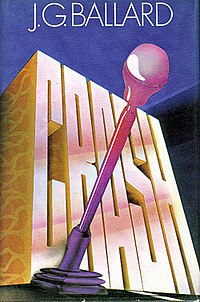This is an old revision of this page, as edited by 24.203.102.251 (talk) at 23:47, 12 October 2009 (→References in popular culture). The present address (URL) is a permanent link to this revision, which may differ significantly from the current revision.
Revision as of 23:47, 12 October 2009 by 24.203.102.251 (talk) (→References in popular culture)(diff) ← Previous revision | Latest revision (diff) | Newer revision → (diff)| This article needs additional citations for verification. Please help improve this article by adding citations to reliable sources. Unsourced material may be challenged and removed. Find sources: "Crash" Ballard novel – news · newspapers · books · scholar · JSTOR (August 2009) (Learn how and when to remove this message) |
 Cover of first edition (hardcover) Cover of first edition (hardcover) | |
| Author | J. G. Ballard |
|---|---|
| Language | English |
| Genre | Novel, Transgressional fiction |
| Publisher | Jonathan Cape |
| Publication date | 1973 |
| Publication place | United Kingdom |
| Media type | Print (Hardcover & Paperback) |
| ISBN | 0-224-00782-3 |
| OCLC | 797233 |
| Preceded by | The Atrocity Exhibition |
| Followed by | Concrete Island |
Crash is a novel by English author J. G. Ballard, first published in 1973. It is a story about car-crash sexual fetishism: its protagonists become sexually aroused by staging and participating in real car-crashes. The novel was written in a highly sensationalized manner.
It was a highly controversial novel: famously one publisher's reader returned the verdict "This author is beyond psychiatric help. Do Not Publish!" The novel was made into a movie of the same name in 1996 by David Cronenberg.
Plot summary
The story is told through the eyes of narrator James Ballard, named after the author himself, but it centers on the sinister figure of Dr. Robert Vaughan, a “former TV-scientist, turned nightmare angel of the expressways”. Ballard meets Vaughan after being involved in a car accident himself near London Airport. Gathering around Vaughan is a group of alienated people, all of them former crash-victims, who follow him in his pursuit to re-enact the crashes of celebrities, and experience what the narrator calls "a new sexuality, born from a perverse technology". Vaughan’s ultimate fantasy is to die in a head-on collision with movie star Elizabeth Taylor.
Analysis
The book explores themes such as the transformation of human psychology by modern technology, and consumer culture's fascination with celebrities and technological commodities. The human characters in the novel are cold and passionless, unable to become sexually excited unless some kind of technology is involved (typically architecture and cars). The gruesome damage inflicted on car-crash victims is not seen as shocking, but as the liberation of new sexual possibilities, that have yet to be explored, such as in one scene where a man and a woman have sex in a car that was involved in an accident, but rather than have vaginal sex, he penetrates a wound on her thigh that she received in a crash.
Finally, the book asks why we, as an enlightened society, accept such a “perverse technology” – that kills a vast number of people yearly – as such an integral part of our culture.
Ballard writes in the foreword: “Do we see, in the car-crash, the portents of a nightmare marriage between technology, and our own sexuality? … Is there some deviant logic unfolding here, more powerful than that provided by reason?”
Quotes
- “After having … been constantly bombarded by road-safety propaganda, it was almost a relief to find myself in a real accident.”
- “Trying to exhaust himself, Vaughan devised an endless almanac of terrifying wounds and insane collisions: The lungs of elderly men punctured by door-handles; the chests of young women impaled on steering-columns; the cheek of handsome youths torn on the chromium latches of quarter-lights. To Vaughan, these wounds formed the key to a new sexuality, born from a perverse technology. The images of these wounds hung in the gallery of his mind, like exhibits in the museum of a slaughterhouse.”
- "The crushed body of the sportscar had turned her into a being of free and perverse sexuality, releasing within its dying chromium and leaking engine-parts, all the deviant possibilities of her sex."
- Ballard (as author) talking about his reasons for writing the book: "I wanted to rub the human face in its own vomit, and force it to look in the mirror"
References in popular culture
- Both the novel and "Warm Leatherette" have been acknowledged as influences on John Foxx's 1980 album Metamatic, which features titles such as "Underpass" and "No-One Driving".
- The Manic Street Preachers' song "Mausoleum" from 1994's "The Holy Bible" contains the famous Ballard quote about the book.
- The Creatures song "Miss The Girl" is directly inspired by the novel.
- The Normal's 1978 song "Warm Leatherette" was also inspired by the novel.
- Tuxedomoon's instrumental "Crash!" was inspired by the novel.
- Stuntman Mike character, from Quentin Tarantino's "Death Proof", aslo gets in car crashes for sexual matter.
References
- Lars Svendsen, A Philosophy of Boredom, trans. John Irons (London: Reaktion Books, 2005), 82.
External links
- Crash by J.G. Ballard, reviewed by Ted Gioia (Conceptual Fiction)
- The Terminal Collection: JG Ballard First Editions